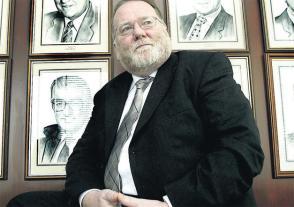Kenny heckler should have targeted Cathal Goan

Pat Kenny's heckler on The Frontline last Monday night, Alan O’Brien of Bluebell in Dublin 12, was focusing on the wrong target. Kenny is not primarily to blame for his arrangement with RTE, under which he was paid close to €1 million per annum during the boom and is now paid more than €600,000.
It is Cathal Goan, director general of RTE, who is primarily culpable. Goan’s explanation for this questionable use of public funds raises further questions, not just about him, but about the point of the poll tax inflicted on every household in the country (aka the licence fee).In case of argument on the matter, the funds involved are public funds, as RTE is owned by the state.
The deal with Kenny resulted in him being paid €922,949 in 2007 and €950,976 in 2008.Sinc e then, his salary has been reduced to €630,000.
But at the time the deal was made, and for two years after, Kenny was the highest paid person we know of in the public service in the country.(The pay of Dr Michael Somers, the head of the NTMA, has never been revealed, but is reported to also exceed €900,000.) Gerry Ryan was the second-highest paid presenter in 2008, earning €629,865. He too has taken a salary reduction.
RTE paid €4.4million to ten of its presenters last year. As the Irish Times has pointed out, these salaries dwarf those paid to world leaders and Irish politicians. Barack Obama’s salary is capped at €276,038.
Brian Cowen’s salary is €232,572. Gordon Brown’s salary is €221,220. Kenny, Ryan, Marian Finucane, Ryan Tubridy, Joe Duffy, Eamon Dunphy, Miriam O’Callaghan and Derek Mooney all earn more than the capped salary for the president of the United States.
Goan’s explanations last October for these salaries was as follows: ‘‘They [the salaries] were set at a different time in a different competitive reality, where some of this talent might be up for poaching by other organisations and, in RTE’s view at the time, they delivered value for money."
But how was it necessary to pay average salaries of €440,000 to prevent these presenters being poached? Who could have afforded to poach Kenny at even half the salary he was earning last year? Not TV3, not Newstalk. So who, then?
The only one of these presenters who might have been poached for a lot of money was Ryan - for he could have been expected to bring a large listenership with him from 2FM.But the others?
Kenny is the best broadcaster in the country (with the exception, perhaps, of Sean O’Rourke and Richard Crowley).
H is radio programme is superb. But its listenership is not that impressive, and there would be no guarantee that he would bring a large listenership to, say, Newstalk. Certainly nothing that would justify paying him close to €1 million, even with a TV programme thrown in.
It is hard to avoid the observation that the payment of these salaries was simply part of a culture of financial squander that prevails - or used to prevail - in RTE.N o expense spared. Yes, things have been pared back of late, but RTE indulged in the excesses of the Celtic tiger as much as many others. And it did so on the back of a massive subsidy from the public, well over €1 billion over seven or eight years.
It was this €1 billion-plus that enabled it to pay such ludicrous salaries, to ensure presenters would not be ‘‘up for poaching by other organisations’’.
Now isn’t that something? The public’s money used to deprive commercial stations of presenters deemed likely to offer an attractive, alternative option to that same public? How is this not anticompetitive conduct?
Now, consider the use by Goan of the word ‘‘talent’’ in relation to the presenters. I am not quibbling with the association of this word with these presenters - although I can think of some instances where that association might be considered dubious.
My point is that the crass, boorish insensitivity of the depiction of presenters as ‘‘the talent’’, with the implication that others associated with the programme they present are not part of that same ‘‘talent’’.
That massive €1 billion subsidy to RTE has done - and is doing - terrible damage to the public interest. This may appear a self-interested observation since I work for a rival station, TV3, but I expressed this same view frequently while broadcasting on RTE Radio 1.Incidentally, any change in the subsidy arrangement would have no consequence for me personally - aside, perhaps, from providing more support for the programme I present.
The use of this subsidy to pay such gross salaries also does damage to this supposed ‘public service’ broadcasting. For isn’t it likely that presenters, paid such multiples of the average national wage or even the average middle-class wage, will reflect unconsciously, in their presentations and questions, the interests of the super-rich income bracket that they have now reached?
Is it any coincidence that the tone of RTE’s coverage of the proposed welfare cuts (‘‘no option’’) and tax increases (‘‘no room’’) is reflective of its new class location? There is no culture at all nowadays in RTE where an awareness of such biases and of the station’s ideology might be critically examined.
By the way, the claim that RTE is offering ‘public affairs broadcasting’ is a conceit.
Most of RTE’s finances are spent on its vast administrative staff and on programmes that are commercially driven, in terms of audience (ie, to get as many viewers as possible).The latter objective is fine, but why should commercial ventures be supported by such massive subsidies? And please, spare us the bit about the symphony orchestra, the choirs, Sunday Mass and state funerals.
